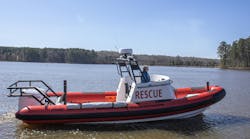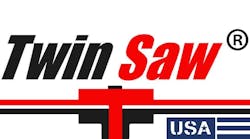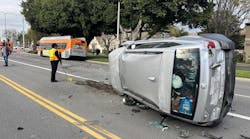TOPIC: 2008 Update
OBJECTIVE: Update of Safe Parking Protocols for Responders Working In or Near Moving Traffic
TASK: Highway incident scene responders shall explain how department protocols for highway incident scene response will be updated to incorporate Title 23 CFR, Part 634, requirements, the ANSI/ISEA 207-2006 "Public Safety Vest" standard, break-away vest features, vehicle chevrons, and ambulance "blocking" procedures.
The University of Extrication first published information on responder safety while working in or near moving traffic as a six-part series beginning with the October 2003 issue of Firehouse® Magazine. The University of Extrication "Safe Parking" series covered many of the aspects of highway scene operations including a look at the struck-by line-of-duty deaths that occur at these incidents, an overview of the federal Manual on Uniform Traffic Control Devices (MUTCD) document that governs our operations at highway incident scenes, procedures for blocking at an incident scene, personal street survival skills for responders at incidents, and a look at highway responder safety equipment. Since the conclusion of the series in early 2004, many things have changed and there is much good news to report. This University of Extrication column will look at changes as well as what's new and different with our traffic incident safe-parking practices and procedures.
Title 23 CFR, Part 634 -- Significant changes have been made since 2004 in responder personal protective equipment (PPE) when working in or near moving traffic; specifically the latest requirement for high-visibility safety vests. The Federal Highway Administration (FHWA), a branch of the U.S. Department of Transportation, issued what is called a "Final Rule" regarding worker visibility for individuals whose jobs require them to work in or near moving traffic. Officially registered as Title 23 CFR Part 634, the ruling establishes a policy that requires the use of high-visibility safety apparel for workers while within the rights of way of federal-aid highways beginning on Nov. 24, 2008. The FHWA is taking this action as a result of a directive from Congress to decrease the likelihood of fatalities or injuries to workers who are exposed to traffic while performing their duties.
Each year, more than 100 workers are killed and over 20,000 are injured in struck-by incidents during highway and street construction and repair activities. The latest statistics for fire department responders show that three individuals died in struck-by incidents in 2006. As many as eight fire responders have died in a single year in struck-by incidents. The FHWA believes that this rule will help reduce these numbers by improving visibility of workers within the federal-aid highway right of way.
Title 23 CFR, Part 634, applies specifically to "people on foot whose duties place them within the right-of-way of a federal-aid highway, such as highway construction and maintenance forces, survey crews, utility crews, responders to incidents within the highway right-of-way and law enforcement personnel when directing traffic, investigating crashes, and handling lane closures, obstructed roadways and disasters within the right-of-way of a federal-aid highway."
As it clearly can be seen, responders from fire departments, EMS teams, law enforcement agencies and tow truck companies fall under this protective apparel ruling. To comply with Title 23 CFR, Part 634, responders will have to wear compliant high-visibility vests anytime they are performing these types of duties at an incident scene. The vests specified in Part 634 must be at least ANSI-compliant Class 2 vests. It is anticipated that a vest specified as an ANSI-compliant "Public Safety Vest" will also be acceptable. It is also clear that this high-visibility vest requirement will be incorporated into the next revision of MUTCD, making it essentially a requirement for any and all roads, streets, highways, expressways, toll roads, tunnels and bridges across the nation.
Best advice: Write your highway safety standard operating guidelines (SOGs) to include the statement "If your feet are on the street, your vest is on your chest!" Then enforce the rules.
ANSI/ISEA 207-2006 Vest Standard, the "Public Safety Vest" -- The American National Standard for High Visibility Safety Products and Headwear (ANSI/ISEA 107-2004) is the official guide for the design, performance specifications, and use of high-visibility and reflective apparel such as highway vests. ANSI 107 establishes three performance classes for vests: Class 1, Class 2 and Class 3. Class 1 represents the lowest level of visibility and Class 3 the highest. Responders to traffic-related incidents must don vests that are labeled Class 2 at a minimum. Class 2 garments are intended for use in activities where high visibility is necessary during inclement weather conditions or because we may be performing tasks that divert our attention from approaching traffic and thus puts us in close proximity to passing vehicles traveling at speeds of 25 mph or higher.
A problem has arisen as law enforcement officials analyzed the design features of the compliant ANSI 107 Class 2 vests they were beginning to wear at highway incidents. Because a Class 2 vest must have 775 square inches of background high-visibility material making up its front, back and sides, the bottom of the vest extends below the beltline of a police officer. This obstructed access to the police officer's tactical belt-mounted equipment such as gun, handcuffs and Mace spray. Because of this concern, a new standard was developed and approved in 2006. Officially titled as ANSI/ISEA 207-2006, this new standard has been given the name "Public Safety Vests" (PSV). The square-inch area requirement for the high-visibility fluorescent background material of a compliant 207 Public Safety Vest has been reduced to only 450 square inches, which falls between the requirements of an ANSI 107 Class 1 vest and a Class 2 vest. The reduced background area requirement allows for shorter vest designs that now give tactical access to the law enforcement officer's equipment belt. The new Public Safety Vest standard also suggests use of design options such as break-away shoulders, interchangeable colored identifiers, radio loops, chest pockets, badge holders and ID panels.
Break-away vest features -- As responders work in or near moving traffic, we attempt to remain in a protected area of the highway; an area protected by the block of an apparatus upstream of our location. Unfortunately, even in the best situations, moving traffic can be very close to us as we work the incident. Because of the possibility of a responder wearing a vest, somehow being snagged by a moving vehicle or even caught and pulled by a piece of rescue equipment, the break-away vest feature is an absolute essential design option that must be specified for your highway safety vests.
Break-away shoulders and chest closures are essential and the key elements of a break-away vest. Hook-and-loop Velcro material must hold the vest together at the top of each shoulder as well as up and down the entire front of the vest. Do not have your shoulder tops sewed and do not order vests with a zipper front closure. If you specify adjustable sides for your vests, these too can be Velcro closures, making them of the break-away design.
With a break-away vest, if it were ever to be snagged, as it is pulled, it literally breaks apart at any or all of the Velcro seams and instantly separates the responder from whatever it is that they are snagged on before they would ever be injured. Break-away shoulders and front opening are life-savers. Make them a part of your vest specifications. "Break-away is for life!"
Chevrons -- In the MUTCD document, the FHWA refers to diagonal lines as vertical panels. They are required to be at the ends of highway guide rails, on bridge pillars, dividers, etc. You'll recognize them on bigger highways by their distinctive black-and-yellow line design.
Because of the work of former Plano, TX, Fire Chief Bill Peterson, the U.S. fire and emergency service has accepted a variation of this diagonal line, or "chevron," design as a method of increasing the visibility and recognition of emergency vehicles positioned at a highway incident to approaching motorists. Fire and EMS responder agencies have come up with a variety of color schemes and chevron locations. The trend to place chevrons on the rear of fire apparatus is now so popular that the National Fire Protection Association (NFPA) 1901 fire apparatus specification committee is considering making chevrons a requirement in the next revision of the Standard.
Here's the deal: To be compliant with MUTCD federal highway standards, the chevron diagonal line pattern must resemble an upside-down letter V. The chevrons have to come together at the top and point downward to the lower, outside corners of the emergency vehicle. If not, then they are non-compliant and would be a liability issue for any department involved in a case where a motorist did run into the back of your apparatus while it was blocking at a highway incident.
Ambulance blocking -- A basic concept of safe parking is that the ambulance will be positioned within a protected area at the highway scene. Typically, this is within the shadow area created by the blocking fire apparatus, downstream of the crash-damaged vehicles. This location not only protects the patient "loading zone," but also allows for efficient departure from the scene once the patient is loaded into the ambulance.
There is one new twist that can be added to ambulance positioning at the incident scene -- ambulance blocking. This refers to a process by which the ambulance driver, as the ambulance comes to a final stop at the scene, places the rear of the ambulance away from the closest moving traffic by simply parking on a slight angle to the traffic; a block position. This block to the right or block to the left position moves the patient loading zone further away from moving traffic, thereby increasing the safety margin between personnel and the dangers of the moving traffic. It is easy and it is simple. It should be mandatory. Ambulance driversâ?¦block your rear!
TASK: Highway incident scene responders shall explain how department protocols for highway incident scene response will be updated to incorporate Title 23 CFR, Part 634 requirements, the ANSI/ISEA 207-2006 "Public Safety Vest" standard, break-away vest features, vehicle chevrons and ambulance "blocking" procedures.
RON MOORE, a Firehouse® contributing editor, is a battalion chief and the training officer for the McKinney, TX, Fire Department. He also authors a monthly online article in the Firehouse.com "MembersZone" and serves as the Forum Moderator for the extrication section of the Firehouse.com website. Moore can be contacted directly at [email protected].





